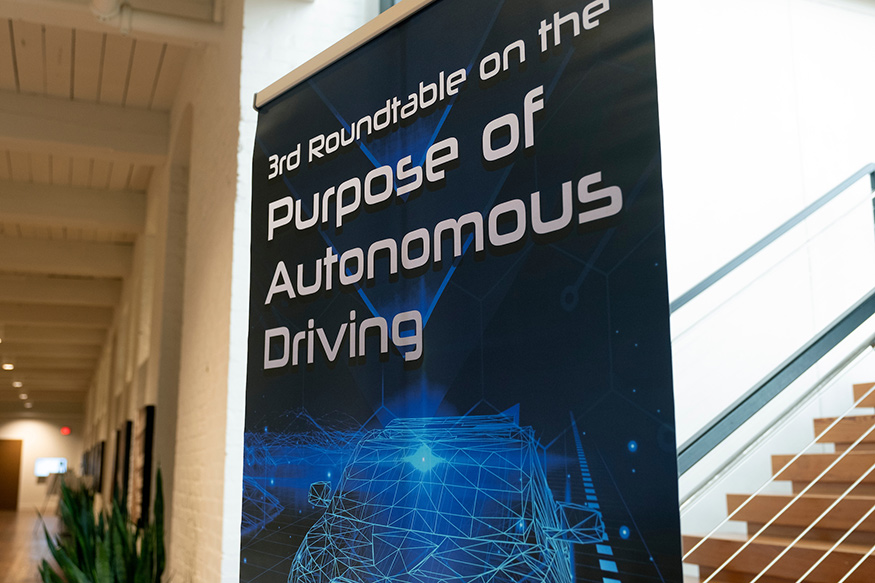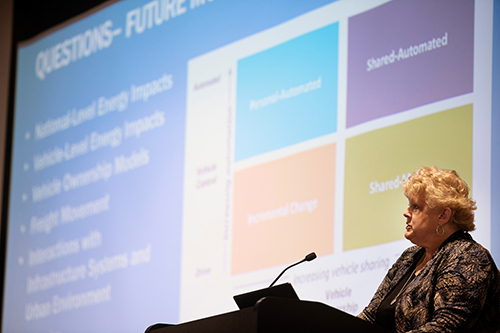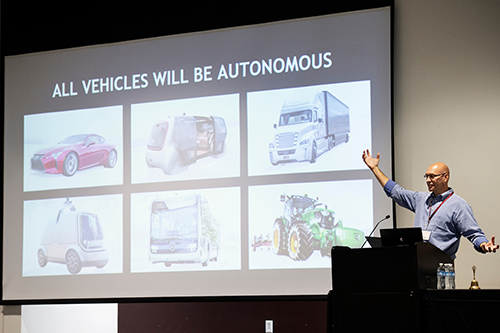MSU's Roundtable on Autonomous Driving Draws International Crowd of Industry Leaders, Researchers
June 1, 2018
Mississippi State and the university’s Center for Advanced Vehicular Systems hosted the third Roundtable on the Purpose of Autonomous Driving May 29-30. The international gathering brought participants from Germany, Japan, The Netherlands, South Korea and across the U.S. to discuss issues related to autonomous driving and advanced driving-assist technologies.
Photo by Megan Bean
Photo by Megan Bean
With participants from Germany, Japan, The Netherlands, South Korea and across the U.S., the conference brought together those on the forefront of research and development for the third Roundtable on the Purpose of Autonomous Driving. Presenters said advancements are certain to bring about continued changes not only for the driving experience, but for society at large, including policy, infrastructure and even cultural changes. While these new technologies offer the prospect of widespread adaptations for transportation systems, speakers noted that change has been continual since automobile makers first developed the “horseless carriage.”
Among keynote speakers, Ann Schlenker, director of Argonne National Laboratory’s Center for Transportation Research, discussed the many questions raised as researchers seek to examine interrelated factors, from population growth and population density to high costs and income inequity to new business models and many partnerships that are shaping the transportation industry.

Ann Schlenker, director of Argonne National Laboratory’s Center for Transportation Research, gave an overview of the many questions and challenges facing researchers and planners in the development of autonomous vehicles.
Photo by Megan Bean
Photo by Megan Bean
She added that in approaching transportation planning, “We can’t just think about personal movement and mobility as to how we get to point A and B; there’s more than that, with the goods and services that are delivered as well. The freight line is increasing exponentially.”
Schlenker added that traffic flow and congestion ramifications are important to study, but air pollution, energy demand and climate change aspects also are imperative.
She explained that a systems look at smart mobility includes data regarding national-level energy impacts, vehicle-level energy impacts, vehicle ownership models, freight movement and interactions with infrastructure systems and the urban environment, among others. The human element, such as consumer behavior surrounding travel decisions cannot be overlooked in transportation research and development, Schlenker added.
Sanford Russell, head of NVIDIA’s Autonomous Driving Ecosystem in North America, said his company is now engaged with more than 370 organizations spanning the industry in pursuit of autonomous vehicle development.

Sanford Russell, head of NVIDIA’s Autonomous Driving Ecosystem in North America, said virtually every aspect of things that move are becoming autonomous.
Photo by Megan Bean
Photo by Megan Bean
He discussed how developers graphically capture different environments and use those images to train “neural networks” as they build artificial intelligence technology.
“The big shift that happened a couple years ago was when we realized that artificial intelligence can solve problems that we, as humans, cannot,” he said.
Russell said that while there are virtually limitless scenarios of driving conditions, artificial intelligence can understand and interpret even edge cases to make determinations.
“Most people talk about the top level, perception – seeing the world, understanding the world, comprehending the world. That then, drives reasoning and prediction,” he said.
“Every 30 milliseconds, at 65 miles per hour, we’re taking in the entire world, creating it, understanding it and making decisions every two feet. And that’s barely fast enough. That’s why it takes a supercomputer,” Russell said.
“How do we have all the possible real-world events out there? That’s where software, simulation and clever engineering come in,” Russell said.
Clay Walden, executive director of MSU’s Center for Advanced Vehicular Systems, highlighted a selection of university projects, including research on pedestrian-vehicle interactions, the Halo Car project, and the development of the MSU Autonomous Vehicle Simulation platform with a heavy focus on off-road environments.
Domenico “Mimmo” Parisi, executive director of MSU's National Strategic Planning and Analysis Research Center, gave a presentation on the value of data science.
“For this to become a reality, for automations to move from lower to highest, an incredible volume of data must be processed in real time,” he said.
He asserted that smart cities would be a critical framework for fully autonomous vehicles to operate, and he discussed the complex issues, such as privacy and data governance, that will impact the future of autonomous vehicles.
“Data may be the last part that engineering worries about, but artificial intelligence cannot work without the right data. You can’t use data unless you have data governance, a smart way to analyze this data, and access to the data,” Parisi said.
Yukiyo Kuriyagawa, associate professor of mechanical engineering at Japan’s Nihon University, said the trip to the MSU conference was valuable for grasping “the big picture of autonomous vehicles.”
Kuriyagawa said, “The small working groups included people from various disciplines and backgrounds. It’s good to know what they are thinking from those research points of view.”
The 2019 conference is scheduled to take place in Germany.
Learn more about MSU’s Center for Advanced Vehicular Systems at www.cavs.msstate.edu. MSU is Mississippi’s leading university, available online at www.msstate.edu.
Written by Allison Mathews
